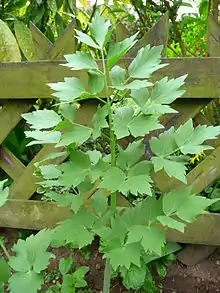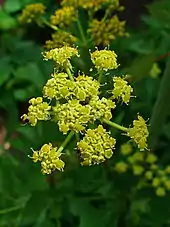Lovage
Lovage (/ˈlʌvɪdʒ/), Levisticum officinale, is a tall perennial plant, the sole species in the genus Levisticum in the family Apiaceae, subfamily Apioideae.[1][2] It has been long cultivated in Europe, the leaves used as an herb, the roots as a vegetable, and the seeds as a spice, especially in southern European cuisine. Its flavour and smell are reminiscent both of celery and parsley, only more intense and spicy than either. The seeds can be used in the same way as fennel seeds.[3]
| Lovage | |
|---|---|
 | |
| Scientific classification | |
| Kingdom: | Plantae |
| Clade: | Tracheophytes |
| Clade: | Angiosperms |
| Clade: | Eudicots |
| Clade: | Asterids |
| Order: | Apiales |
| Family: | Apiaceae |
| Subfamily: | Apioideae |
| Genus: | Levisticum Hill |
| Species: | L. officinale |
| Binomial name | |
| Levisticum officinale | |
Description

Lovage is an erect, herbaceous, perennial plant growing to 1.8–2.5 m (6–8 ft) tall, with a basal rosette of leaves and stems with further leaves, the flowers being produced in umbels at the top of the stems. The stems and leaves are shiny glabrous green to yellow-green and smell somewhat similar to celery when crushed. The larger basal leaves are up to 70 cm (28 in) long, tripinnate, with broad triangular to rhomboidal, acutely pointed leaflets with a few marginal teeth; the stem leaves are smaller, and less divided with few leaflets. The flowers are yellow to greenish-yellow, 2–3 mm (1⁄16–1⁄8 in) diameter, produced in globose umbels up to 10–15 cm (4–6 in) diameter; flowering is in late spring. The fruit is a dry two-parted schizocarp 4–7 mm (3⁄16–1⁄4 in) long, mature in autumn.[4]
Distribution
Levisticum officinale is native to Afghanistan and Iran, [5] but has been introduced to most of Europe, and parts of South-East Asia, North and South America.[5] It has been long cultivated in Europe, the leaves being used as an herb, the roots as a vegetable, and the seeds as a spice, especially in southern European cuisine.[3]
Properties and uses
The leaves can be used in salads, or to make soup or season broths, and the roots can be eaten as a vegetable or grated for use in salads. Its flavour and smell are reminiscent both of celery and parsley, only more intense and spicy than either. The seeds can be used as a spice in the same way as fennel seeds.[3]
- In the Netherlands, lovage leaves are traditionally cooked with white asparagus and salt;[6] and served with boiled eggs.[7]
- In Ukraine, lovage (in Ukrainian любисток/liubystok), is considered an aphrodisiac. Traditionally, an infusion prepared from lovage leaves has been used by women for rinsing their hair, in order to attract men with the pleasant spicy smell of the plant. Nowadays, hair conditioners can be bought which contain lovage extract to strengthen the hair. Lovage leaves and roots are also used in salads and as a spice in Ukraine.
- In Romania, the leaves are a preferred seasoning for the various local broths and are just as popular, in this respect, as parsley or dill.[8] Furthermore, the dried foliage and seeds are added to pickled cabbage and cucumbers both to aid in their preservation and to add flavour to them.[9]
- In the UK, an alcoholic lovage cordial is traditionally added to brandy as a winter drink and is or was popular in Cornwall where it was originally added to slightly spoiled smuggled brandy to hide the taste of salt.[10]
The roots, which contain a heavy, volatile oil, are used as a mild aquaretic.[11] Lovage root contains furanocoumarins which can lead to photosensitivity.[12]
Etymology

The name "lovage" is from "love-ache", ache being a medieval name for parsley; this is a folk-etymological corruption of the older French name levesche, from late Latin levisticum, in turn thought to be a corruption of the earlier Latin ligusticum, 'of Liguria' (northwest Italy), where the herb was grown extensively.[13] In modern botanical usage, both Latin forms are now used for different (but closely related) genera, with Levisticum for (culinary) lovage, and Ligusticum for Scots lovage, a similar species from northern Europe, and for related species.[13]
References
- Pimenov, M. G. & Leonov, M. V. (1993). The Genera of the Umbelliferae. Royal Botanic Gardens, Kew. ISBN 0-947643-58-3.
- Downie, S. R., Plunkett, G. M., Watson, M. F., Spalik, K., Katz-Downie, D. S., Valiejo-Roman, C. M., Terentieva, E. I., Troitsky, A. V., Lee, B.-Y., Lahham, J., and El-Oqlah, A. (2001). "Tribes and clades within Apiaceae subfamily Apioideae: the contribution of molecular data". Edinburgh Journal of Botany. 58 (2): 301–330. doi:10.1017/s0960428601000658.
{{cite journal}}: CS1 maint: multiple names: authors list (link) - Huxley, A., ed. (1992). New RHS Dictionary of Gardening. ISBN 0-333-47494-5.
- Interactive Flora of NW Europe: Levisticum officinale (Lovage)
- "Levisticum officinale W.D.J.Koch". Plants of the World Online. Royal Botanic Gardens, Kew. Retrieved 17 March 2023.
- Thyra (2017-06-30). "Thyra: Lovage/Løvstikke". Thyra. Retrieved 2020-09-30.
- "Blogwatching: white asparagus – A Dutch ritual". DutchNews.nl. 15 June 2020. Retrieved 2020-09-30.
- "În ce fel de ciorbe este indicat să folosim leuşteanul. Cât de multe frunze puternic aromate putem pune". adevarul.ro. 23 February 2017. Retrieved 2019-03-17.
- "Cum faci cele mai gustoase murături". Adevarul newspaper. 13 September 2018. Retrieved 17 March 2019.
- Information on Lovage Cordial Archived 2011-10-06 at the Wayback Machine
- "Community herbal monograph on Levisticum officinale Koch, radix" (PDF). European Medicines Agency. 2012-03-27. Retrieved 2015-07-28.
- Ashwood-Smith MJ, Ceska O, Yeoman A, Kenny PG (May 1993). "Photosensitivity from harvesting lovage (Levisticum officinale)". Contact Dermatitis. 26 (5): 356–7. doi:10.1111/j.1600-0536.1992.tb00138.x. PMID 1395606. S2CID 30154586.
- "lovage". Oxford English Dictionary (Online ed.). Oxford University Press. (Subscription or participating institution membership required.)
External links
 Media related to Levisticum officinale at Wikimedia Commons
Media related to Levisticum officinale at Wikimedia Commons